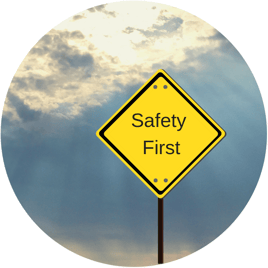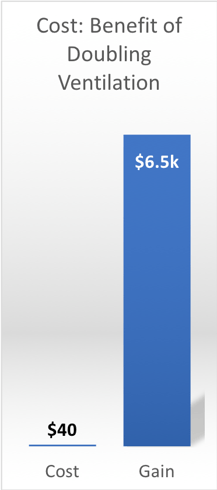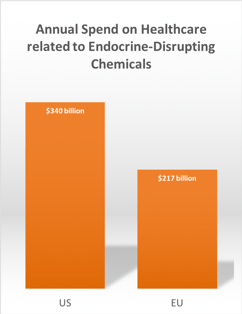 What is the business case for taking responsibility for the health and environmental impacts of products?
What is the business case for taking responsibility for the health and environmental impacts of products?
In researching this question, I came across too many reasons to list in one post, so I’m breaking it into a 5-part series on the Business Case for Product Stewardship.
The first topic is Health and Safety.
I modified the working definition from the Northwest Product Stewardship Council to condense it, and incorporate health. Product Stewardship involves the design, manufacture, sale, use and disposal of a product and taking responsibility to minimize the product's environmental and health impacts throughout each stage. Whichever stage has the greatest ability to minimize the impacts across the lifecycle (often the manufacturing stage), has the greatest responsibility to do so.
.png?width=217&name=Safety%20image%20(2).png) 1. Hazardous substances harm your workers. We’ve all seen the ‘x’ days since an accident signs around warehouses. This number relates to both physical accidents and chemical incidents. It’s an important visual reminder for people to be careful and stay out of harm’s way. There is a healthy trend to adhere to protocols to avoid physical accidents. However, in some industries, simply showing up for work can be dangerous.
1. Hazardous substances harm your workers. We’ve all seen the ‘x’ days since an accident signs around warehouses. This number relates to both physical accidents and chemical incidents. It’s an important visual reminder for people to be careful and stay out of harm’s way. There is a healthy trend to adhere to protocols to avoid physical accidents. However, in some industries, simply showing up for work can be dangerous.
A recent report from New Zealand shows that workers die from exposure to harmful substances 10 times more often than from accidents. Workers in the agricultural sector were more at risk- by seven to nine times! Exposure to the chemicals in fertilizers was cited as the main cause. If exposure to these chemicals is harming, and sometimes killing workers, it makes sense to find safer alternatives.These chemicals affect more than just the workers. How do those chemicals affect farmers, people living downstream and those consuming the produce from these farms? Using safer chemicals is better for everyone involved. Want to check the score of your chemicals? Search for free:
 2. Your customers- 87% of them globally- seek out beauty and personal care products made without harsh or toxic chemicals. And, according to MadeSafe, 84% are much more likely to shop at retailers that have taken steps to eliminate toxic chemicals from products they sell. Your end-users are ultimately the ones who define the success of your products. Because the majority of them want to know what’s in your products, and they are educating themselves about ingredients, transparency sells.
2. Your customers- 87% of them globally- seek out beauty and personal care products made without harsh or toxic chemicals. And, according to MadeSafe, 84% are much more likely to shop at retailers that have taken steps to eliminate toxic chemicals from products they sell. Your end-users are ultimately the ones who define the success of your products. Because the majority of them want to know what’s in your products, and they are educating themselves about ingredients, transparency sells.
3. Inadvertent ingestion of chemicals migrating into processed food from packaging and equipment used in food manufacturing poses risks to children and pregnant women, as noted in an article by the New York Times. Phthalates were banned from children's toys a decade ago, citing concerns including behavior problems and genital birth defects, yet they are still making their way into children's bodies. While never added to food, phthalates are used in personal care products as well as in food processing and packaging as solvents and to soften plastics in adhesives. They leach into food from equipment including tubes, conveyer belts, gaskets and plastic packaging. Phthalates bind with fats, and tend to build up in fatty foods, including cheese, baked goods, infant formula, meats and oils.
Are you using phthalates or other chemicals of concern in your manufacturing process? Search Toxnot's Database to find alternatives.
 4. Green buildings are healthier. According to an article in National Geographic published last year, what we breathe indoors is on average two to five times more toxic than what is typically outside. Green buildings initiated with a focus on reducing water and energy usage to take on a wider view of environmental health by making buildings healthier for people.Scientific research has demonstrated that greener buildings result in fewer sick days among workers and students.
4. Green buildings are healthier. According to an article in National Geographic published last year, what we breathe indoors is on average two to five times more toxic than what is typically outside. Green buildings initiated with a focus on reducing water and energy usage to take on a wider view of environmental health by making buildings healthier for people.Scientific research has demonstrated that greener buildings result in fewer sick days among workers and students.
Studies mentioned in the article have also shown that well-ventilated buildings increase cognitive function, leading to higher productivity among workers and higher test scores among students. The extra productivity among workers was valued at $6,500 per worker. The cost to double the ventilation capacity averaged $14- $40 per occupant annually. Looking to create a green building publication (e.g. HPD, Declare Label, LEEDv4 report)? Start here.

5. It’s expensive for all of us! Beyond the lost productivity mentioned above, if you use toxic chemicals in your production, think of the costs spent on: adhering to regulations; fines for when you don't; disposal of chemicals and degreasers; employee protection such as gloves, goggles and masks. The list goes on. For the rest of us, not involved in chemical manufacturing, the US spends $340 billion annually on health care costs associated with endocrine- disrupting chemicals. The EU was determined to spend the equivalent of $217 billion annually.These endocrine-disrupting chemicals alone attribute to costs that are 2% of our GDP.
The more studies that are done, the more consumers will demand to know what’s in their products. This summer, the American Academy of Pediatrics announced that environmental organic acids have been linked to endocrine disruption in children. It's time to track the substances in your products; phase out the most harmful ones; search for alternatives and report on your progress.
The costs to product manufacturers being caught flat-footed in an ever-knowledgeable consumer base could mean the end to your brand reputation. In every imaginable case, gaining a better understanding of your raw materials, and their hazard scoring, will help guide you to the next step. Your customers aren't expecting you to be perfect. They are looking for acknowledgement that you are making progress.
Ready to get started? That’s where we come in. Toxnot provides hazards screening to start the critical process of alternatives assessment, and help to identify admirable substitutions in your products. Our chemical hazards database contains information on over 50,000 substances and over 46,000 GreenScreen List Translator™ scores. Toxnot helps you improve health and sustainability across the global supply chain with insight about the chemicals and materials that go into them.
Related Article:
Admirable Substitutions: Preferred Chemistries in the Circular Economy


